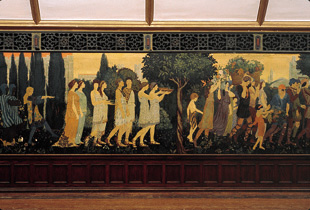|
|
 City's
colors revealed in mural book City's
colors revealed in mural book
Mary
Lackritz Gray, AM'78, became interested in Chicago murals ten
years ago while waiting for a performance to begin at the restored
Auditorium Theatre downtown. "I looked up at the dancing figures
painted on the proscenium of the stage, and began to wonder
what they were all about," she writes in the introduction to
her new book, A Guide to Chicago's Murals (Chicago, 2001).
Gray,
the author of A Guide to Chicago's Public Sculpture (Chicago,
1983), immersed herself in books and archives at the Chicago
Historical Society, the Harold Washington Library, and the Art
Institute's Ryerson and Burnham Libraries, and toured the city
and suburbs, "finding that one discovery led to another."
One
of her discoveries was that there was too much mural art in
Chicago to fit in one book. From late-19th-century scenes recalling
European mythology to Depression-era Americana sponsored by
the Works Project Administration to colorful community-themed
works enlivening the city's poorer neighborhoods in recent decades,
Chicago teems with public art, and Gray had to make difficult
choices. The 181 murals pictured in her guide represent a range
of ages, artists, periods, and aesthetics. Addenda include lists
of murals not featured, artist biographies, and a glossary of
terms.
Two
murals in the guide are located on campus. The excerpts that
follow are reprinted with the permission of the author and the
Press. More information on A Guide to Chicago's Murals can be
found at www.press.uchicago.edu. - C.S.

Athletic
Games in the Middle Ages,
1904
Bartlett Gymnasium
Artist: Frederic Clay Bartlett
Bartlett Gymnasium is one of the more than 50 buildings constructed
in the Gothic style on the University of Chicago campus between
1892 and 1932. The artist Frederic Bartlett worked with the architects
to create an interior that blended Gothic with the English Arts
and Crafts style, a movement popular in Chicago at the turn of
the century, which emphasized craftsmanship and handwork. Built
as a men's gym and donated by Bartlett's father in memory of another
son who had recently died, the building features a mural that
depicts an athletic tournament set in the Middle Ages. Bartlett
thought the "age of chivalry" could be inspiring to the students.
The panoramic frieze is mounted between the dark oak wainscoting
and the cornice on each side of the doorway. In the center is
a painted shield bearing the dedication: "To the advancement of
Physical Education and the Glory of Manly Sports this gymnasium
is dedicated to the memory of Frank Dickinson Bartlett, 1880-1900."
An inscription under one of the scenes reads: "How happy is he
born and taught that serveth not another's will: whose armor is
his honest thought and simple truth his utmost skill." In describing
the mural Bartlett wrote, "The crowd looking on the games are
in gorgeous holiday attire-brocades stiff with gold, cut velvet,
and rich silks, with jewels of equal splendor. Many of the ornaments
are raised in 'gesso' and gilded in antique gold leaf after the
manner of early English and Italian decorations." The building
is to be converted to a dining hall, but the murals will remain
in place.
The Masque
of Youth, 1918
Ida Noyes Hall
Artist: Jesse Arms Botke
In 1916 some 300 students, alumni, and schoolchildren participated
in a dramatic, allegorical outdoor presentation called "The Masque
of Youth," celebrating both the quarter centennial of the University
of Chicago and the opening of Ida Noyes Hall, a new building for
women students. Two years later the picturesque pageant was recreated
on the wall of the small third-floor theater. The inspiration
of the art of the early Italian Renaissance and the later Pre-Raphaelite
movement is apparent in these highly decorative murals. A series
of panels mounted between the windows and on the walls of the
room depict the procession of costumed figures that had paraded
past the Gothic buildings of the university campus. The Spirit
of Gothic Architecture and Alma Mater, in long white gowns, stand
in front of the Law School, where the masque was presented. Youth,
crowned with spring flowers, is followed by children dressed in
blue representing Lake Michigan. Veiled figures carry a symbolic
moon, and dancers energetically pull the golden sun chariot past
Harper Memorial Library. The blue-robed spirit of Worship carries
the sacred book, and Knowledge bears her lighted lamp. Finally,
the personification of the city follows two pages waving the blue
banner that denotes the lake, and a group of figures portray the
endless cycle of Youth. Also represented are the university coat
of arms and symbols of the divisions of the university: Archaeology,
Chemistry, Medicine, Literature, and Art. In 1995 an ongoing process
of cleaning and restoration was begun, revealing again the freshness
of the mural's images and its glowing colors. Patron La Verne
Noyes, who had funded the building in memory of his wife, called
the murals "a crowning halo."
|
|

OCTOBER 2001
>
> Volume
94, Number 1
FEATURES
> >
Collective
efforts
> > News
you can abuse
> > The
collecting mania
CLASS NOTES
> >
Class News
> > Books
> > Deaths
RESEARCH
> >
Investigations
DEPARTMENTS
> >
Editor's Notes
> >
From the
President
> > Letters
> > Chicagophile
ARCHIVES
CONTACT
ABOUT THE MAGAZINE
SEARCH/SITE
MAP
ALUMNI
GATEWAY
ALUMNI
DIRECTORY
THE UNIVERSITY |

![]()
 City's
colors revealed in mural book
City's
colors revealed in mural book
